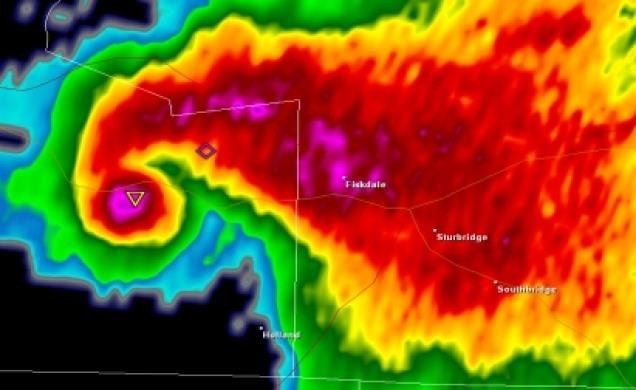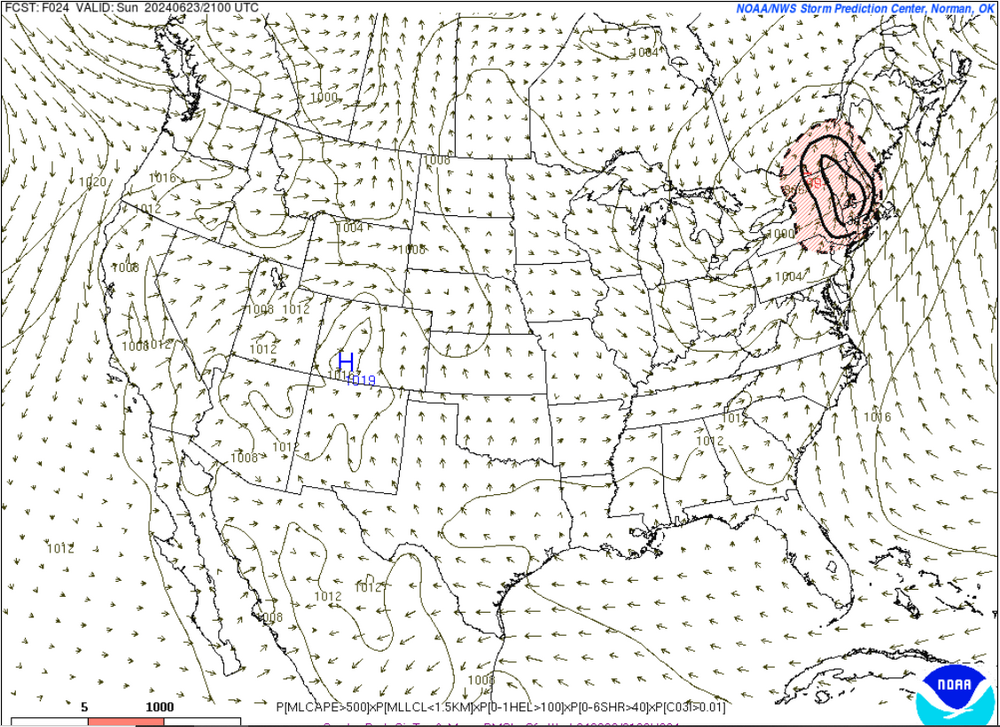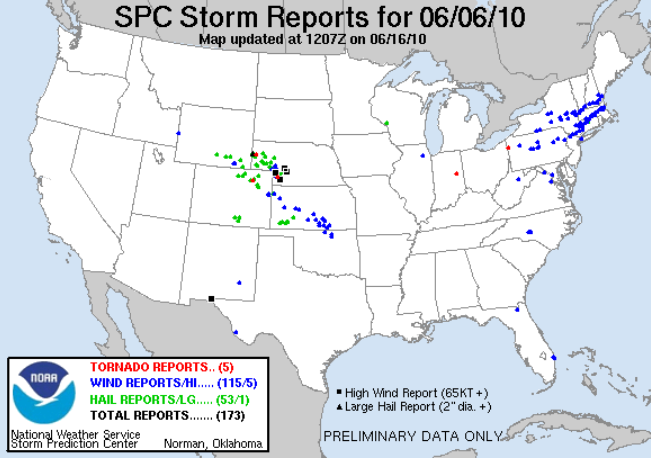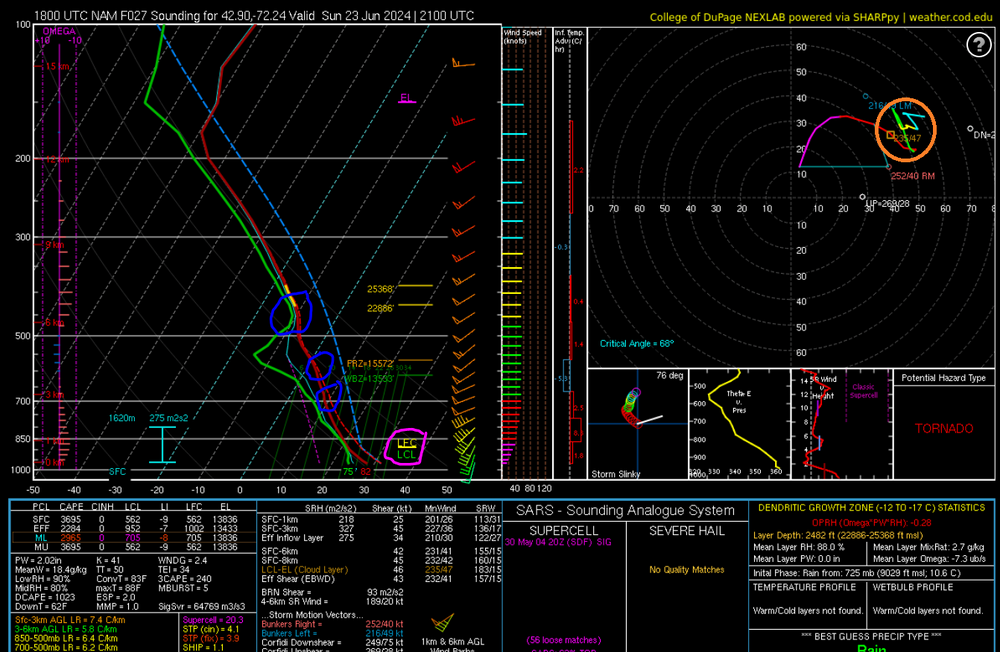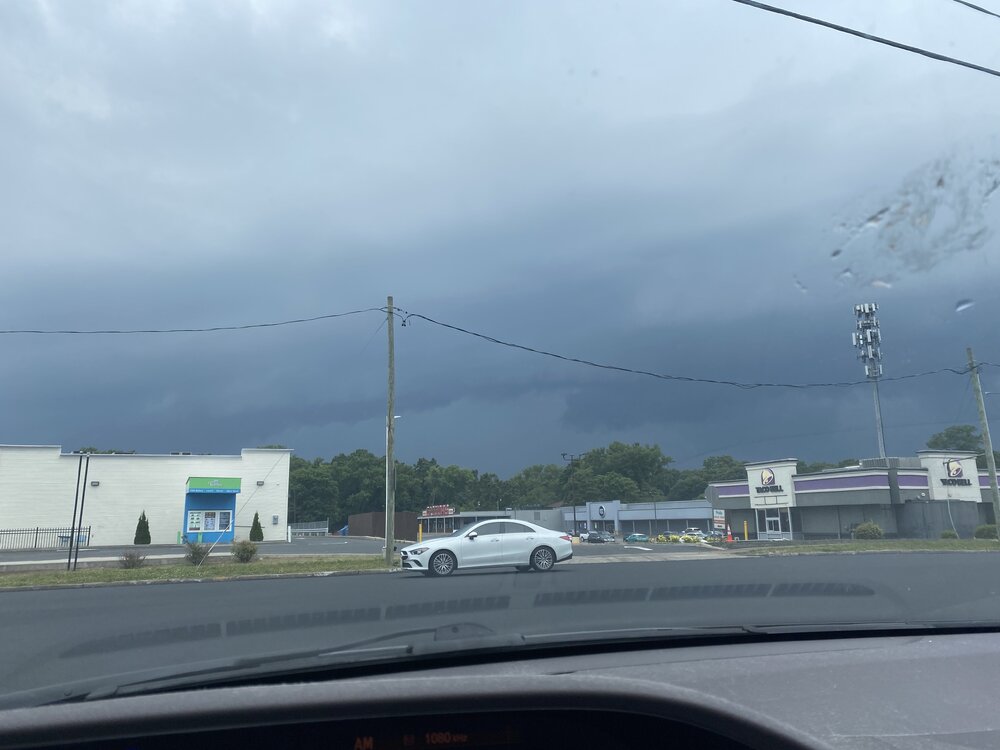-
Posts
78,312 -
Joined
-
Last visited
Content Type
Profiles
Blogs
Forums
American Weather
Media Demo
Store
Gallery
Everything posted by weatherwiz
-
I don't think there is going to be much activity but there may be a window between like 5-8 PM for activity to develop across western CT as there is some shortwave energy approaching. Showers may start popping during the afternoon but they will struggle to intensify given the capping and weak forcing.
-
Yeah chasing here sucks. You can’t even really chase. I know I call it chasing but I don’t really chase. What I just try to do is pick an area which looks to be a decent spot before hand and then look on google maps for any like open fields, golf courses, etc. in the vicinity. Then get there a few hours before hand. I always prefer northern CT being in the game because BDL is great for views. I tend though not to go after stuff as it’s ongoing. Too much traffic, if you are in areas with lots of trees blocked roads become a concern, and getting caught in the torrential downpours driving can be dicey. Difficult to see and the way people drive…always afraid of getting rear ended
-
May have to end up going a bit farther north into New Hampshire. Have to look deeper into stuff but looks like storm mode is going to be super messy. Also looking like a bit later for timing (not a bad thing).
-
Could start seeing stuff fire as early as 1-2 PM. Mostly in the 3-8 window though. Another round of isolated storms late evening and early overnight but little svr risk
-
The NAM/HRRR are spitting out some of the highest supercell/STP values I can remember here. Of course though that doesn’t mean everything, you still need mature enough storms to utilize the environment and that’s the question right now, how many can?
-
I'm noticing some of the point-and-click soundings are showing 700-500mb lapse rates around 6.5C/KM but looking at the soundings, those raw numbers don't look right. Not sure that really means anything, I would assume the raw numbers you see in the bottom left box aren't used anywhere (like in the computation of the CAPE).
-
Great post. I am a bit more uncertain as well as to how much discrete cells we will see tomorrow. I was entertaining the idea yesterday that we could see a line of supercells possibly, but I should have known that was extremely unlikely. But to the bolded...that's exactly what I think we'll end up seeing. A few cells that are able to really utilize the environment and produce. Most of the storms may struggle to end up producing. But we'll see what happens...if we get dews 73-76 like the NAM has this makes things a bit more interesting.
-
Pretty interesting to see that area highlighted...it was an area I had interest in for some of the greatest potential.
-
Agreed. Even up north though...the storm mode is going to be key in terms of tornado potential. The 0z HRRR develops alot of activity, so storm mode may get very messy and that will have an impact on updrafts and may add additional challenges for updrafts to really become mature.
-
Shear is certainly there. Definitely some messy looks. One of the several reasons we won't see widespread, high-end severe and why we'll see probably one or two concentrated swaths of some severe.
-
Wow this is a substantial increase in the 21z SPC SREF SIG TOR ingredients versus previous runs. This tends to run wild during low CAPE/high shear events so to see values this high for an environment like tomorrow is pretty wild.
-
Between like 2-7 PM for the storms ahead of the pre-frontal trough. Although could see stuff starting to fire as early as 1. There may be some storms with the actual cold front during the late evening and overnight but these may be more on the isolated side.
-
Sad…three people injured by lightning strikes at the TPC in Cromwell
-
pretty much lol
-
When Kevin switches from BDL to ORH
-
That was 6/1/2011
-
Friend of mine posted these to Facebook (gave me permission to post). Took these in Rocky Hill. Definitely looks like wall cloud or funnel cloud
-
-
Sticking with EML's, the reason why they can contribute to widespread, high-end severe weather is they keep the atmosphere capped which prevents cumulus and storms from developing too early. Even if the convective temperature is reached, you'll often need very strong lift to break the cap. So, what this does is allow for extreme instability to develop at the sfc. When the cap breaks, parcels then violently accelerate upwards and because of the steep lapse rates (decrease of temperature with height) in the 700-500mb layer, parcels will continue to rapidly accelerate well into the upper troposphere. This results in rapidly strengthen thunderstorms which can quickly become severe. With the absence of an EML for tomorrow, below is a forecast sounding from the 18z NAM within southwest New Hampshire which I will illustrate a few things: 1. This is a very good shear profile, as evident by the hodograph in the upper right. You have speed shear present, especially in the lowest 3km and you have directional shear present, both in the lowest 3km and especially the lowest 3km. However, note the messy look of the hodograph (circled in orange). This is indicative of a veer-back-veer wind profile which is present in the 700mb to about 450mb level. This is something which can be critical to the potential for tornado outbreaks in the Plains. While this look DOES NOT inhibit tornado potential, it can negate the potential for multiple or several tornadoes. Sometimes, "busts" in the Plains are the result of veer-back-veer wind profiles. 2. With the lack of an EML, mid-level lapse rates are on the weak side. They aren't terrible, forecast to be around 6-6.5C/KM, but what is hurting the lapse rates are these subtle warm layers (circled in blue) and a evident cap just above 500mb. What does this mean? As mentioned above, what steep lapse rates do is enhance upward parcel acceleration. When parcels are able to rapidly accelerate upwards this can result in vigorous updrafts and powerful thunderstorms. Given the atmosphere is moderately unstable, parcels will rapidly accelerate towards the LCL and LFC (note the two are close together). So once we get the proper lift, storms will rapidly develop. As parcels continue to accelerate upwards, the parcel acceleration will slow due to these subtle warm layers and it is very possible the cap above 500mb could hinder the severity as parcels could struggle to continue accelerating. These factors, along with the lack of the EML will prevent a more widespread event from occurring. All in all, while the atmosphere will be conducive for severe weather and a few tornadoes for a good chunk of the region, the area of greatest potential is going to be much more narrow, thus this will not be a widespread, high-end event.
-
I think another factor to consider too is the difference between stronger and weaker tornadoes. Back in the 2010 setup, which had a 10% hatched area with a lack of an EML, the wording was for a few strong tornadoes (hence the hatched). Lack of EMLs don't necessarily hinder tornado potential, however, they do greatly hinder the likelihood for stronger tornadoes. Another factor to also consider is storm mode. Obviously, one attribute of EMLs is due to the strong capping, they can keep storms discrete which increases the likelihood for thunderstorms to become mature and fully utilize the environment around them. For tomorrow, if storms are able to remain on the discrete side, the environment is supportive for multiple tornadoes so I think that factors into the 10% probability.
-
Any of the local news stations really. NBC30 is usually top notch, especially when Ryan is working and covering warnings.
-
Rotation started right over west Hartford where I lived for so many years
-
We had 10% a few years back (think 2020) and again 5/15/18.
-
wagons north tomorrow. Reminds me of winter

